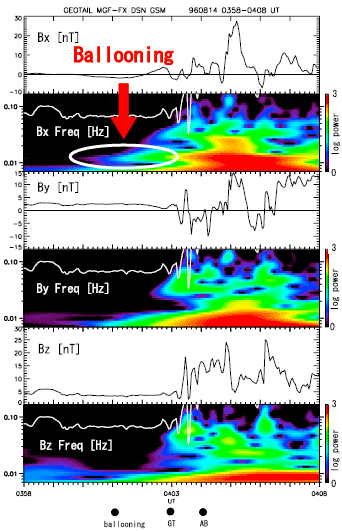► Japanese
► DARTS of the Month

Ballooning Mode Wave as a Precursor of the Substorm Onset: Geotail Observations
A substorm is a global energy dissipation process in near-Earth space, which is accompanied by very active auroras in the nightside polar regions. The triggering mechanism of the substorm has not been elucidated for decades. Ballooning instability excited in the magnetotail has been proposed as a possible candidate mechanism and now attracts attention to explain the longitudinally aligned auroral "beads" that develop into auroral breakup. However, the presence of the ballooning instability has not been observationally established.
The ballooning mode waves are expected to cause magnetic field deformation in a specific frequency band in the close vicinity of the magnetic equator at approximately 10 Earth radii down the tail. On the basis of more than 10 years of in situ observations from the Japan-USA joint Geotail satellite, Saito et al. (2008) have recently identified four events whose characteristics are consistent with the ballooning mode waves. They discovered that the waves appeared a few min before the dipolarization and the substorm onsets. It was also found that the estimated wavelengths are consistent with what is expected for a typical scale of the auroral "beads".
The present study shows, for the first time, strong evidence that the ballooning instability really takes place in the magnetotail as a precursor of the substorm onset. In the future we will study how the ballooning instability is excited and what kind of roles it plays in the substorm trigger.
Miho Saito (ISAS/JAXA, University of Tokyo)
Yukinaga Miyashita (ISAS/JAXA)
May 2008





